12 Exercises To Improve Squat Strength & Form
Author:
Reviewed by:
(21 years of Oly Lifting experience)
Unlock your full potential by engaging with our experts and community! Have questions about your fitness journey or looking for expert advice on weightlifting techniques? Don’t hesitate — leave a comment below and Sergii Putsov will provide a personalized answer and insights to help you reach your goals.
Torokhtiy is reader-supported. Some links are affiliate links, and we may earn a commission at no extra cost to you. See our disclosure page for details.
As strong squat is more than just a feat to strength, it’s a cornerstone of a transformative fitness journey. This foundational movement not only builds muscle across your lower body, but also enhances core stability, improves your balance and boosts athletic performance. The squats influence on overall physics is profound, making it a crucial exercise in any strength training program.
Incorporate exercises to improve squat like Romanian lifts for hamstrings, front squats for quadriceps and barbell hip thrust for glute to enhance your back squat strength. Consistent practice with these drills will lead to better squat performance and technique.
However, elevating squat to the next level isn’t just about repetition, it requires a strategic approach, focusing on targeted exercises that enhance the power and efficiency of each squat movement.
The exercises to improve squat are engineered to fortify the muscle groups, refine technique and increase strength in a measured sustainable manner. By incorporating these specific movements into your routine, you can improve your squatting capability, leading to notable gains both in the gym and in daily life.
As we unpack these best exercises to increase squat, keep in mind that their transformative potential extends far beyond the way you lift, they are building blocks for a stronger, more resilient body.
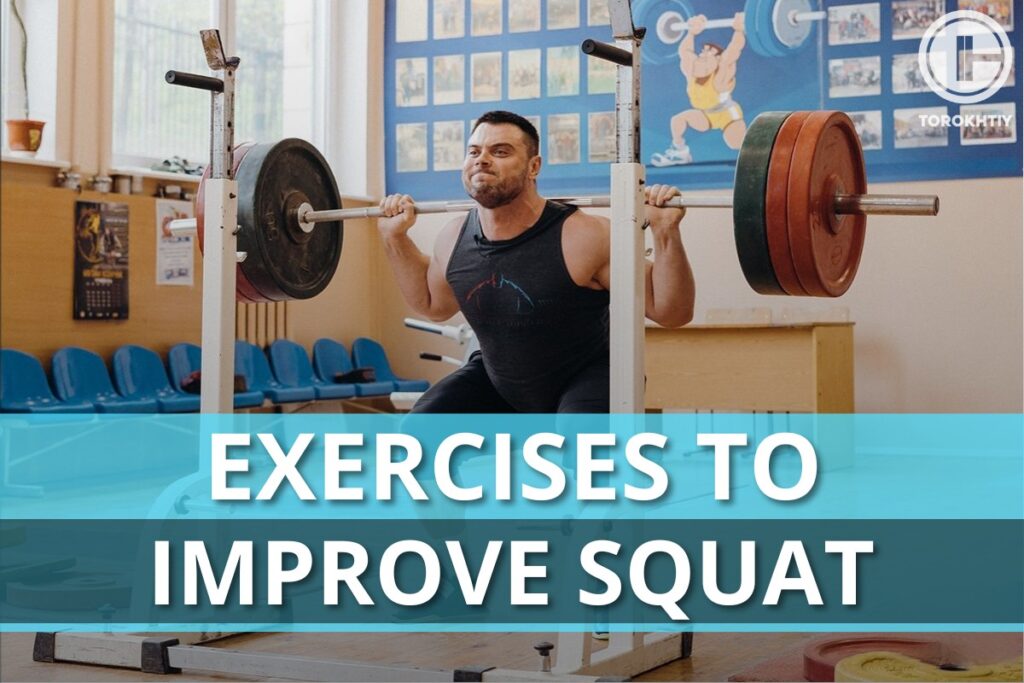
Squat Anatomy and Perfecting Form
Understanding the squats begins with the biomechanics of the movement. A squat is not just a leg exercise: it’s a full body engagement that challenges the muscles from your shoulders to your ankles. The movers in a squat are the quadriceps, hamstrings and glutes. These muscles work in concert to lower and raise the body. while the adductors and abductors of the thighs stabilize the movement. The calves provide a base of support and the back muscles engage to keep the torso upright.
The core encompassing the abdominal muscles and the muscles around the spine act as a central support system, bracing the torso to protect the spine. A strong core is essential for maintaining posture and form throughout the movement.
Proper technique starts with the stance – feet should be shoulder width-apart or slightly wider with those pointed slightly outward. When descending, the hips should move back and down, while the chest stays lifted and the back remains neutral, not rounded or overly arched. Depth is important: ideally the hip crease should come below the knees at the bottom of the squat. Driving the movement from the heels, the body should rise back to the starting position, with the hips and knees extending simultaneously. This is a technical aspect of how to increase squat weight.
To perfect deform, it’s vital to engage the muscles correctly: the glutes at the bottom of the squat to drive upwards, and the quads to extend the knee. Breathe control is also key – inhale in your stomach on the way down and exhale at the end of the ascent.
Practicing with light weights or bodyweight, is essential to ingrain the muscle memory of proper form before adding significant laws. The goal is to create a strong fluid motion that maximizes muscle engagement, and minimizes the risk of injury.
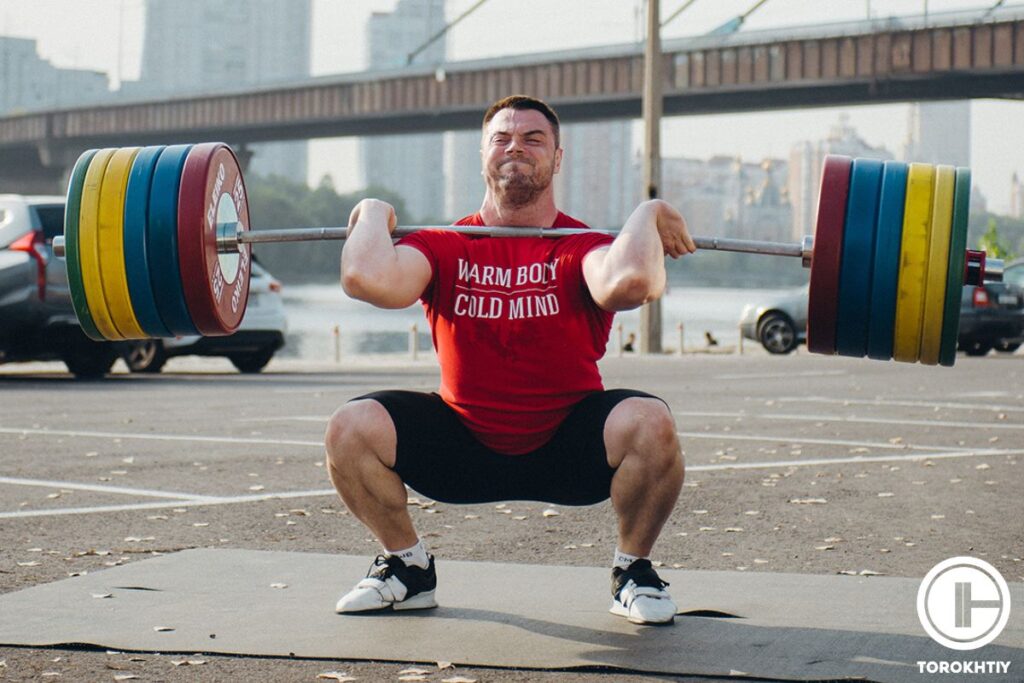
Prime Movers: 5 Key Exercises for Quads and Hamstrings
The quadriceps and hamstrings are essential drivers in the squat movement. Strengthening these muscle groups is pivotal for improving squat performance. Here’s the detailed breakdown of the exercises to increase squat max and to fortify these muscles.
1. Front Squats
Goal: specifically target the quads, more intensely than traditional squats.
Technique: position the barbell on the front of your shoulders, take the bar with the front track position or cross your arms to hold the bar in place, keep elbows high; decent, keeping the knees in line with the toes, and maintain the torso upright.
2. Romanian Deadlift (RDL)
Goal: emphasize hamstring and glute development critical for the upward phase of the squat.
Technique: with feet hip-width apart, hold a bar with pronated grip, hinge at the hips to lower the bar along your thighs, keeping a slide bend in the knee and a flat back.
3. Leg press
Goal: build overall leg strength with a focus on the quads.
Technique: sit in the leg press machine with your back flat against the pad, place the feet shoulder-width apart on the platform and push up without locking your knees.
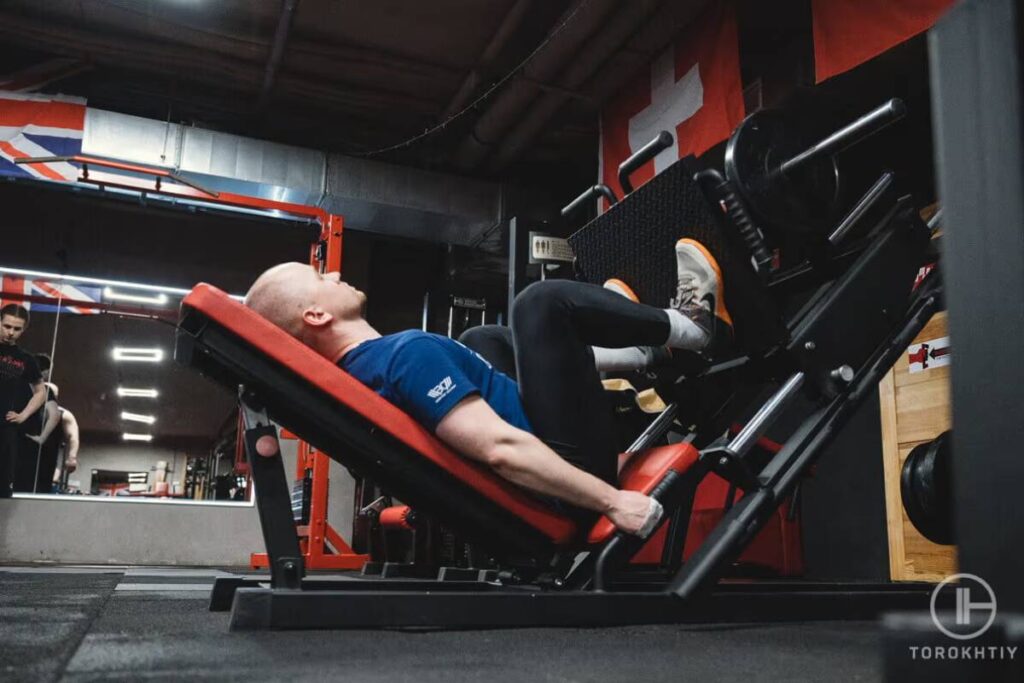
4. Hamstring Curls
Goal: isolate and strengthen the hamstrings.
Technique: Lying prone on the leg curl machine, hook your heels under the roller pad and curl the weight towards your glutes.
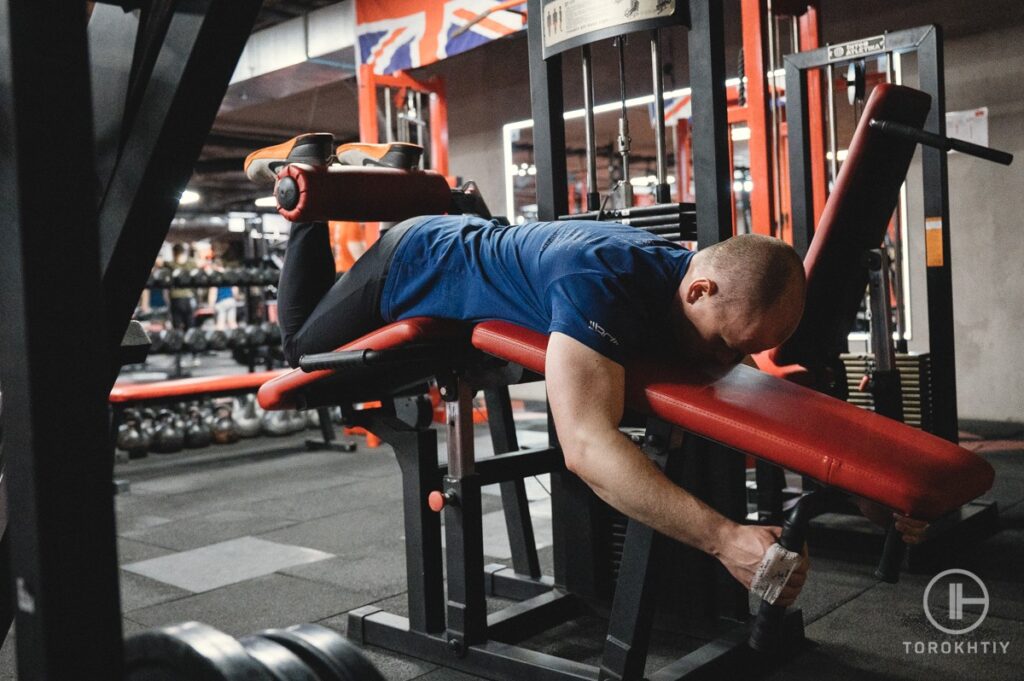
5. Bulgarian Split Squats
Goal: this exercise enhances quad and hamstring strength and improves balance and coordination.
Technique: with one foot behind you on a bench, squat down on your front leg keeping your torso upright.
For all these exercises, proper warm-up sets are crucial before moving to heavier weights. The key is to progress gradually focusing on form to ensure maximum benefit and safety. Regularly incorporating these best exercises to improve squat into the training regime will result in substantial gains over time.
The Power of Hip Drive: 3 Glute Exercises
Activating and strengthening glutes is crucial for powerful hip extension in the squat. Here are some of the top exercises to enhance glue strength and contribute to an improved squat.
Follow us!

Free!
Get a 2-week Weightlifting Program as a bonus for the subscription to kickstart your training plan!

Free!
1. Bar Hip Thrusts
Goal: directly target the glutes for maximum engagement and strength development; this is a must have drill for workouts to increase squat.
Technique: sit on the ground with your upper back against the bench, roll a bar over your hips, plant your feet flat and thrust your hips upward, fully extending and squeezing the glutes at the top.
2. Box Squats
Goal: teach proper squat form while focusing on the posterior chain, including the glutes.
Technique: with a box positioned behind you at knee level, squat back until your glutes touch the box, then explosively drive up through the heels, maintaining a strong glute contraction.
3. Kettlebell Swings
Goal: build explosive hip drive and glute power.
Technique: with feet shoulder-width apart swing a kettlebell from between your legs to chest height, driving the movement with your hips and glutes.
Unleashing Core Strength
Core strength is fundamental for squat stability and power. A robust core braces the squat, allowing for better transfer of force and protection of the spine. The following core exercises can significantly impact your squat performance.
1. Planks
Goal: strengthen the entire core with a focus on endurance and stability.
Technique: maintain a forearm plank position, ensuring a straight line from shoulders to heels and brace your core throughout the hold.
2. Ab Wheel Rollouts
Goal: target the anterior core muscles, enhancing stability during squats.
Technique: from kneeling a position, roll the ab wheel forward until your body is nearly parallel to the ground and pull back to the start using your core muscles.
3. Hanging Leg Raises
Goal: develop lower abdominal strength and hip flexor control.
Technique: Hanging from a pull up bar, raise your legs to parallel with the floor without swinging, engaging your core throughout the movement.
4. Weighted Cable Crunches
Goal: provide resistance training for the core simulating the compression force during squats.
Technique: kneel below the cable machine, hold the rope attachment behind your neck and crunch downwards, focusing on contracting your abs.
A strong core is not built through isolation alone is the application during the compound movements like squats. Integrating these exercises into your workouts to improve squat should be strategic, ensuring your core is strong, but not fatigued when it’s time to squat. Regularly training the core can lead to noticeable improvements in squat, stability and overall power.
Active Recovery and Injury Prevention
Active recovery days are critical in any squat progression plan, not only for injury prevention, but also for continuous improvement. Such days should focus on activities that promote blood flow without adding stress on the central nervous or muscular and skeletal systems which aids in the repair and strengthening of tissues, stressed by heavy squats.
1. Mobility Work
Mobility drills enhance the range of motion around key joints, involved in squatting, such as the hips, knees and ankles. Dynamic movements that mimic the squat motion can maintain or even improve flexibility and fluidity in the squat movement pattern.
2. Stretching
Post-training static stretching can alleviate muscle tightness and promote recovery. Targeting the hip flexors, quads, hamstrings, and calves – key players in the squat – is essential. Consistent stretching routines can lead to improved performance and decreased risk of strains.
3. Light Activity
Activities like walking, cycling or swimming on off days can keep the muscles loose and promote circulation, which is vital for muscle repair and nutrient delivery. These should below impact and moderate in intensity to avoid fatigue.
4. Technical Work
Recovery days are also an opportunity for technique refinement. Practicing squat movements with a broomstick or an empty bar, can reinforce modern patterns without the strain of added weight.
🔻GET A FREE PROGRAM DEMO: 12 Week Squat Program by Oleksiy Torokhtiy
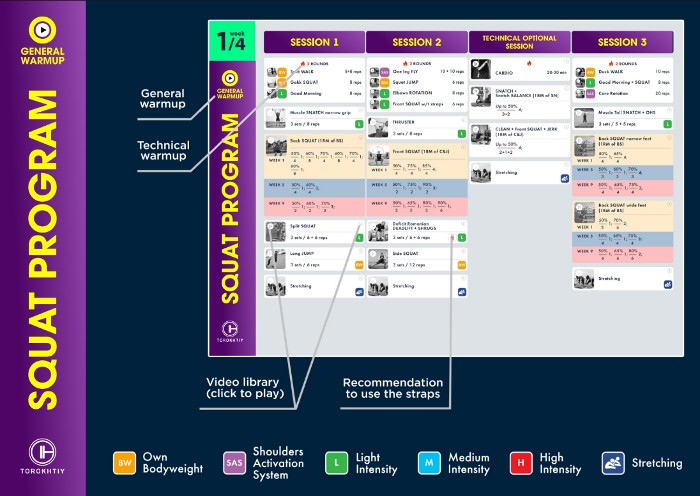
Do you want to double your squat strength? In just 12 weeks, you’ll be able to boost your squat results.
Enter your details and get a free demo (1 free week) of the squat program straight into your inbox.
FAQ
Why Can’t I Squat Deep?
Difficulty squatting deeply can be due to factors like limited hip, ankle or thoracic spine mobility, tight muscles, poor technique or inadequate stability. Strengthening and mobility exercises, focused on this area, along with practice can improve squat depth.
Is Squatting Past 90 Degrees Bad?
Squatting past 90° is not inherently bad and can increase leg strength and hip flexibility if done with proper form. However, it’s crucial to listen to your body and adjust depth based on individual mobility and comfort to prevent injury.
Do Full Squats Damage Your Knees?
Full squats do not damage knees when performed correctly. In fact, they can strengthen the joints and surrounding muscles. Proper technique and progression, along with adequate mobility and strength are key to squatting safely.
Conclusion
Incorporating the outlined exercises into your lifting plan can lead to substantial squat strength gains, underscoring the profound impact of targeted training. Consistency, proper technique and progressive load increases are the pillars of improvement as you embark on this journey. Remember that each rep builds more than muscle – it builds character. Did I miss any solid leg exercise? Let me know in the comment section.
Also read:
- Arm Exercises for Weightlifting: Are They Important?
- 4 Benefits Of Weightlifting For Seniors + 8 Simple Exercises
- 6 Dumbbell Wrist Exercises for Strength and Stability
- How To Get Bigger Wrists: Growth Strategies & Exercises
- Leg Exercises For Bad Knees: Strengthening Your Legs Safely
- Squat Depth: How Deep Should You Squat? (PhD Explains)
- 4 Front Squat Benefits That Will Make You Add It to Your Routine
Referenses:
- Contreras B, Vigotsky AD, Schoenfeld BJ, Beardsley C, Cronin J. A Comparison of Gluteus Maximus, Biceps Femoris, and Vastus Lateralis Electromyographic Activity in the Back Squat and Barbell Hip Thrust Exercises. J Appl Biomech. 2015 Dec;31(6):452-8. doi: 10.1123/jab.2014-0301. Epub 2015 Jul 24. PMID: 26214739.
- Barbalho M, Coswig V, Souza D, Serrão JC, Hebling Campos M, Gentil P. Back Squat vs. Hip Thrust Resistance-training Programs in Well-trained Women. Int J Sports Med. 2020 May;41(5):306-310. doi: 10.1055/a-1082-1126. Epub 2020 Jan 23. PMID: 31975359.
- Delgado J, Drinkwater EJ, Banyard HG, Haff GG, Nosaka K. Comparison Between Back Squat, Romanian Deadlift, and Barbell Hip Thrust for Leg and Hip Muscle Activities During Hip Extension. J Strength Cond Res. 2019 Oct;33(10):2595-2601. doi: 10.1519/JSC.0000000000003290. PMID: 31356511.
- Moore D, Semciw AI, Pizzari T. A SYSTEMATIC REVIEW AND META-ANALYSIS OF COMMON THERAPEUTIC EXERCISES THAT GENERATE HIGHEST MUSCLE ACTIVITY IN THE GLUTEUS MEDIUS AND GLUTEUS MINIMUS SEGMENTS. Int J Sports Phys Ther. 2020 Dec;15(6):856-881. doi: 10.26603/ijspt20200856. PMID: 33344003; PMCID: PMC7727410.
- Calatayud J, Escriche-Escuder A, Cruz-Montecinos C, Andersen LL, Pérez-Alenda S, Aiguadé R, Casaña J. Tolerability and Muscle Activity of Core Muscle Exercises in Chronic Low-back Pain. Int J Environ Res Public Health. 2019 Sep 20;16(19):3509. doi: 10.3390/ijerph16193509. PMID: 31547140; PMCID: PMC6801665.
- Photos by MerinoPhotos, Canva, photo by undrey’s Images, Canva
Why Trust Us?
With over 20 years in Olympic weightlifting, strength training, nutrition coaching, and general fitness our team does its best to provide the audience with ultimate support and meet the needs and requirements of advanced athletes and professional lifters, as well as people who strive to open new opportunities and develop their physical capabilities with us.
By trusting the recommendations of our certified experts in coaching, nutrition, and sports training programming, as well as scientific consultants, and physiotherapists, we provide you with thorough, well-considered, and scientifically proven content. All the information given in the articles concerning workout programming, separate exercises, and athletic performance, in general, is based on verified data.
The product testing process is described in more detail here.
Author: Sergii Putsov
Head of Sport Science, PhD
Best Results: Snatch – 165 kg,
C&J – 200 kg
Sergii Putsov, Ph.D., is a former professional weightlifter and National team member, achieving multiple medals in the 94 kg weight category at national competitions. With a Master’s degree in “Olympic & Professional Sport Training” and a Sport Science Ph.D. from the International Olympic Academy, Greece, Sergii now leads as the Head of Sport Science. He specializes in designing training programs, writing insightful blog articles, providing live commentary at international weightlifting events, and conducting educational seminars worldwide alongside Olympic weightlifting expert Oleksiy Torokhtiy.
Reviewed by: Oleksiy Torokhtiy
Olympic Weightlifting Champion, PhD in Sport Science
Best Results: Snatch – 200 kg,
C&J – 240 kg
Oleksiy Torokhtiy is a professional athlete boasting 20 years of experience in Olympic weightlifting. With multiple European and World titles under his belt, he has showcased his prowess in two Olympic Games (Beijing 2008 and London 2012). Upon concluding his illustrious career, Oleksiy dedicated himself to coaching. By 2022, he had conducted over 200 weightlifting seminars worldwide. He is the visionary behind an international sportswear and accessories brand known for its motto, “Warm Body Cold Mind.” Additionally, he is an esteemed author and the creator of a series of training programs and eBooks.




Still have questions after reading our article? Unlock your full potential by engaging with our experts and community! Don’t hesitate — leave a comment below and Sergii Putsov will provide a personalized answer and insights to help you reach your goals.